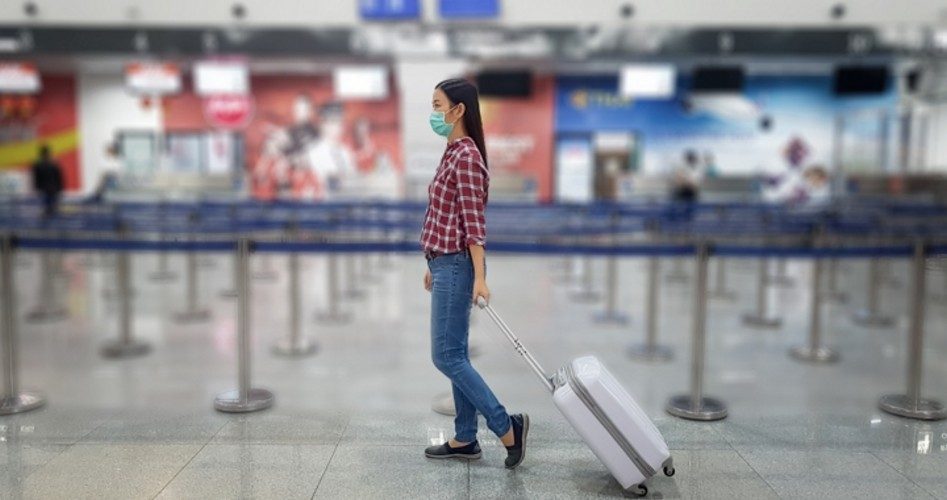
Estimates from the International Monetary Fund (IMF) show the impact of measures mandated by the Chinese communist government to staunch the spread of the COVID 19/Coronavirus. In January, the IMF reduced its growth outlook from 6.4 percent for 2020 to 6.1 percent. On Thursday it reduced that outlook further, to 5.6 percent, thanks to what the IMF’s managing director Kristalina Georgieva called the “sheer geographic spread” of the virus.
And the group’s forecast could be reduced further: “We are already looking at adverse scenarios … in which the impact on growth for China is more significant.… The Chinese authorities themselves are recognizing that there would be lower growth this year.”
The IMF noted, for example, that the purchasing managers’ indexes (PMIs) for both the manufacturing and the service sectors of China’s economy, released by China’s National Bureau of Statistics on Sunday, fell precipitously in February. The Caixin manufacturing PMI fell a staggering 50 percent, from 51.8 (anything above 50 is expansion; below is contraction) in January to 26.5 in February. Its services PMI fell from 54.1 in January to 29.6 in February, while its “export orders” sub-index plunged from 51 in January to 28.7 in February.
Chinese authorities reported to the IMF that output in the country’s factories has fallen by 40 percent, while ANZ (the Australian and New Zealand Banking Group) estimated that China’s economy is operating at only 20 percent of capacity. As a result, ANZ revised its outlook on China as well, estimating that China’s GDP growth would slide to 4.1 percent this year, with growth of just two percent in the first quarter compared to a year ago.
There are other indicators reflecting China’s economic woes. Subway ridership across eight major cities was just one-fifth of normal on Thursday, according to the Wall Street Journal’s calculations. And those calculations don’t include the city of Wuhan, the center of the outbreak, where the subway that normally carries 3.4 million passengers every day has been closed for weeks.
Of China’s 290 million “migrant” workers (those who travel from rural areas to the cities to take on construction, manufacturing or service jobs), only 80 million had returned to work by mid-February.
Another indicator is provided by NASA’s pollution monitoring satellites. From January 1 to 20, and from February 10 to 25, pollution — the density of NO2 concentrations from cars, trucks, buses, and power plants — was almost 30 percent lower than normal. The images can be seen here.
Stephen Roach, a senior fellow at Yale University’s Jackson Institute for Global Affairs, was even more negative. On CNBC’s Squawk Box last Friday, he said, “The impact of unprecedented quarantines and restrictions on travel have brought the Chinese economy right now to a virtual standstill.”
There is concern that China’s economic slowdown could last for months. And there is talk that the COVID 19/Coronavirus is threatening the communist power structure in the country as well. China expert Gordon Chang, in an interview at the Conservative Political Action Conference in Washington, D.C., said, “Maybe we’re starting to see the same dynamic [that Chernobyl had on the demise of the Soviet Union in the late 1980s] now. The Communist Party certainly is weakened and it’s fighting to keep itself in place.” He added that the Chinese Communist Party is “in trouble” with a number of academics in Beijing demanding that President Xi Jinping resign.
Chang added, “We don’t know what the consequences of [the economic slowdown] will be, but we know that after the death of one of the doctors in Wuhan [Dr. Li Wenliang, the whistleblower] who tried to tell people about what was going on, his death caused white hot anger.”
The devastation of China’s economy could have lasting impacts, not the least of which is its forcible detour from the communists’ projected plan — the Chinese Dream — to dominate the world. Instead it has the potential of turning that Chinese Dream into a nightmare for the country’s leaders and the first light of freedom for its citizens.
Image: asiandelight via iStock / Getty Images Plus
An Ivy League graduate and former investment advisor, Bob is a regular contributor to The New American, writing primarily on economics and politics. He can be reached at [email protected].



